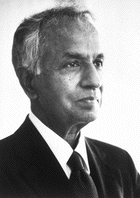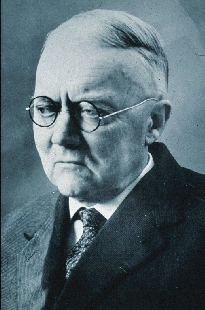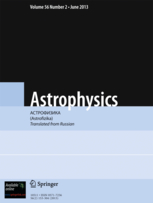
Subrahmanyan Chandrasekhar was an Indian-American theoretical physicist who made significant contributions to the scientific knowledge about the structure of stars, stellar evolution and black holes. He was awarded the 1983 Nobel Prize in physics along with William A. Fowler for "...theoretical studies of the physical processes of importance to the structure and evolution of the stars". His mathematical treatment of stellar evolution yielded many of the current theoretical models of the later evolutionary stages of massive stars and black holes. Many concepts, institutions and inventions, including the Chandrasekhar limit and the Chandra X-Ray Observatory, are named after him.
The Astrophysical Journal (ApJ) is a peer-reviewed scientific journal of astrophysics and astronomy, established in 1895 by American astronomers George Ellery Hale and James Edward Keeler. The journal discontinued its print edition and became an electronic-only journal in 2015.

The American Astronomical Society is an American society of professional astronomers and other interested individuals, headquartered in Washington, DC. The primary objective of the AAS is to promote the advancement of astronomy and closely related branches of science, while the secondary purpose includes enhancing astronomy education and providing a political voice for its members through lobbying and grassroots activities. Its current mission is to enhance and share humanity's scientific understanding of the universe as a diverse and inclusive astronomical community.

Ernst Julius Öpik was an Estonian astronomer and astrophysicist who spent the second half of his career (1948–1981) at the Armagh Observatory in Northern Ireland. He is best known for his pioneering work on solar system dynamics.

Astrophysics is a science that employs the methods and principles of physics and chemistry in the study of astronomical objects and phenomena. As one of the founders of the discipline, James Keeler, said, astrophysics "seeks to ascertain the nature of the heavenly bodies, rather than their positions or motions in space–what they are, rather than where they are", which is studied in celestial mechanics.

Otto Lyudvigovich Struve was a Ukrainian-American astronomer of Baltic German origin. Otto was the descendant of famous astronomers of the Struve family; he was the son of Ludwig Struve, grandson of Otto Wilhelm von Struve and great-grandson of Friedrich Georg Wilhelm von Struve. He was also the nephew of Karl Hermann Struve.

Gustav Wilhelm Ludwig von Struve was a Baltic German astronomer, part of the famous Baltic German Struve family. In Russian, his name is sometimes given as Lyudvig Ottovich Struve or Lyudvig Ottonovich Struve.

Monthly Notices of the Royal Astronomical Society (MNRAS) is a peer-reviewed scientific journal in astronomy, astrophysics and related fields. It publishes original research in two formats: papers and letters. MNRAS publishes more articles per year than any other astronomy journal.

Bryan Malcolm Gaensler is an Australian astronomer based at the University of California, Santa Cruz. He studies magnetars, supernova remnants, and magnetic fields. In 2014, he was appointed as Director of the Dunlap Institute for Astronomy & Astrophysics at the University of Toronto, after James R. Graham's departure. He was the co-chair of the Canadian 2020 Long Range Plan Committee with Pauline Barmby. In 2023, he was appointed as Dean of Physical and Biological Sciences at UC Santa Cruz.
Vytautas Straižys was a Lithuanian astronomer. In 1963–65 he and his collaborators created and developed the Vilnius photometric system, a seven-color intermediate band system, optimized for photometric stellar classification. In 1996 he was elected a Corresponding Member of the Lithuanian Academy of Sciences. Straižys was an editor of the journal Baltic Astronomy. He spent a lot of time working at the Molėtai Astronomical Observatory. Asteroid 68730 Straizys in 2002 was named after him.

Alexander Dalgarno FRS was a British physicist who was a Phillips Professor of Astronomy at Harvard University.

Astronomische Nachrichten, one of the first international journals in the field of astronomy, was established in 1821 by the German astronomer Heinrich Christian Schumacher. It claims to be the oldest astronomical journal in the world that is still being published. The publication today specializes in articles on solar physics, extragalactic astronomy, cosmology, geophysics, and instrumentation for these fields. All articles are subject to peer review.

Astronomy & Astrophysics (A&A) is a monthly peer-reviewed scientific journal covering theoretical, observational, and instrumental astronomy and astrophysics. It is operated by an editorial team under the supervision of a board of directors representing 27 sponsoring countries plus a representative of the European Southern Observatory. The journal is published by EDP Sciences and the current editors-in-chief are Thierry Forveille and João Alves.

Astronomy Reports, is a Russian, monthly, peer reviewed, scientific journal. This journal tends to focus its publishing efforts on original research regarding astronomical topics. Other types of reporting are also included such as chronicles, proceedings of international conferences, and book reviews. Founded in 1924, it is described as the most prominent astronomy journal during the age of the Soviet Union. Originally a print version, it is also available online. The editor-in-chief was Alexander A. Boyarchuk, Institute of Astronomy of the Russian Academy of Sciences, Moscow, Russia.

The Journal of the Korean Astronomical Society is a bimonthly open access peer-reviewed scientific journal of astronomy published by the Korean Astronomical Society. It covers original work and review articles from all branches of astronomy and astrophysics. The journal was established in 1968 and the editor-in-chief is Sascha Trippe.
Publications of the Astronomical Society of Australia is a peer-reviewed scientific journal covering all aspects of astrophysics and astronomy. The editor-in-chief is Ivo Rolf Seitenzahl.

Astrophysics is a peer-reviewed scientific journal of astrophysics published by Springer. Each volume is published every three months. It was founded in 1965 by the Soviet Armenian astrophysicist Viktor Ambartsumian. It is the English version of the journal Astrofizika, published by the Armenian National Academy of Sciences mostly in Russian. The current editor-in-chief is Arthur Nikoghossian.
The Planetary Science Journal is a peer-reviewed open access scientific journal of astrophysics and astronomy, established in 2020. It is published by IOP Publishing on behalf of the American Astronomical Society. The founding editor-in-chief is Faith Vilas
Georg Thomas Sabler was an astronomer and geodesist of Baltic German origin active in territories of modern-day Estonia, Lithuania, Ukraine, and Russia.












